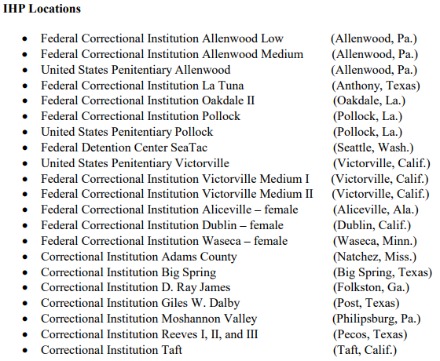Facts about the Institutional Hearing Program

- Introduction
- History of the Institutional Hearing Program
- Functions of the Institutional Hearing Program
- List of Institutional Hearing Program Locations
- Conclusion
Introduction
In January 2018, the Executive Office for Immigration Review (EOIR) released an interesting fact sheet on the Institutional Hearing Program [PDF version]. The expansion of the Institutional Hearing Program has been an early priority of the Trump Administration's new immigration enforcement strategy. For example, in his February 20, 2017 memorandum, then-Secretary of Homeland Security John Kelly directed the Department of Homeland Security (DHS) to work with the EOIR to initiate removal proceedings against incarcerated aliens under the purview of the Institutional Hearing Program [see section]. Then, just over a month later, Attorney General Jeff Sessions announced that the DOJ had moved to expand the Institutional Hearing Program [see blog].
In this article, we will examine the new EOIR Fact Sheet on the Institutional Hearing Program to better understand what is becoming a larger immigration enforcement tool for the government.
History of the Institutional Hearing Program
The EOIR Fact Sheet details the origins of the Institutional Hearing Program. The Program was established by the EOIR in order to implement section 701 of the Immigration Reform and Control (IRCA) Act of 1986. The Fact Sheet explains that the purpose of the program is to identify criminal aliens who are serving sentences in Federal prison in order that their deportation/exclusion/removal proceedings can be completed while they are serving their sentence.
Functions of the Institutional Hearing Program
The EOIR Fact Sheet explains that, under the Institutional Hearing Program, the “EOIR provides in-person and video teleconference immigration proceedings to determine whether alien inmates are removable from the United States and, if removable, whether they are statutorily eligible for any form of protection or relief from removal.” This process allows the U.S. Immigration and Customs Enforcement (ICE) to issue final orders of removal to federally incarcerated aliens who may then be expeditiously removed when they are released from Bureau of Prisons (BOP) custody. The EOIR Fact Sheet adds that one objective of the Institutional Hearing Program is to “avoid releasing removable aliens into prolonged ICE custody, or into the community, pending future adjudication of their immigration case.”
List of Institutional Hearing Program Locations
The EOIR Fact Sheet provided a list of Institutional Hearing Program locations. This list is current as of January 18, 2018:

Conclusion
The Institutional Hearing Program allows for the conduct of removal proceedings for certain criminal aliens while in BOP prisons. An alien subject to removal proceedings under the Institutional Hearing Program is not precluded from contesting his or her removal charges or seeking any form of relief or protection for which he or she is eligible. Any alien facing removal proceedings, whether under the Institutional Hearing Program or otherwise, should consult with an experienced immigration attorney for case-specific guidance. An experienced attorney will be able to assess the specific facts of a given case and determine the best path forward under the applicable circumstances.
We will continue to update the site with information on the Institutional Hearing Program and other news in the area of immigration removal and deportation defense [see category].